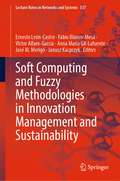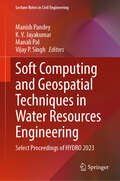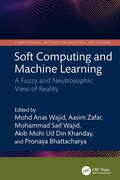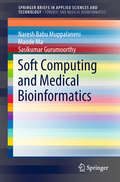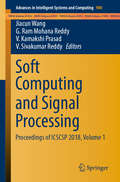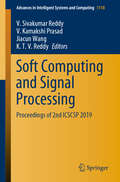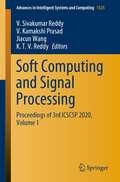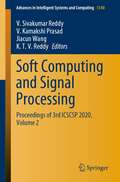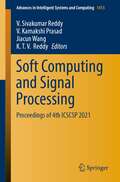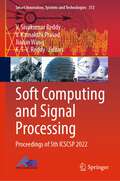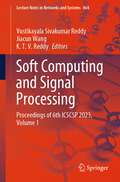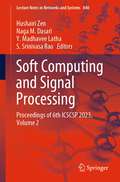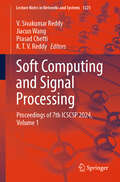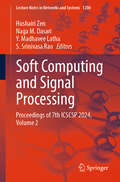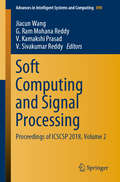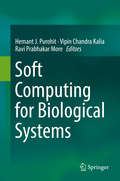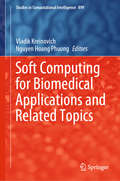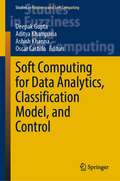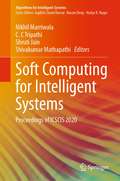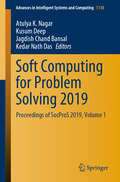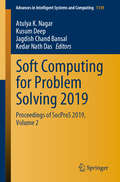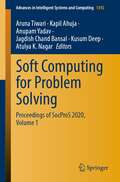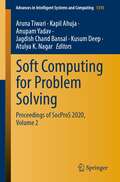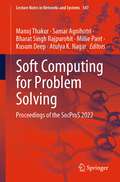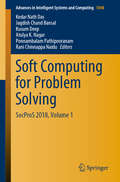- Table View
- List View
Soft Computing and Fuzzy Methodologies in Innovation Management and Sustainability (Lecture Notes in Networks and Systems #337)
by Anna Maria Gil-Lafuente Janusz Kacprzyk José M. Merigó Ernesto León-Castro Fabio Blanco-Mesa Victor Alfaro-GarcíaThis book provides recent research on soft computing and fuzzy methodologies in innovation management and sustainability. The uncertainty in the business world is increasing. Significant changes are generated unexpectedly, so using fuzzy logic and soft computing methods allows us to create flexible scenarios adaptable to new realities. Within the book, we will find different applications of fuzzy methodologies that can apply to various topics such as sustainability, innovation, tourism, costs, exports, systems administration, among others. The book's main contribution is the applicability of the various methodologies to specific cases, which allows generating a relationship between theory and practice. In addition, it has some bibliometric studies on various topics that give us a visualization of what has happened and where multiple topics are headed. This book is recommended mainly for students who wish to know how the various fuzzy and soft computing tools can be taken to real situations, allowing a better understanding of these and generating new visions of future applicability.
Soft Computing and Geospatial Techniques in Water Resources Engineering: Select Proceedings of HYDRO 2023 (Lecture Notes in Civil Engineering #397)
by Vijay P. Singh Manish Pandey K. V. Jayakumar Manali PalThis book comprises proceedings of the 28th International Conference on Hydraulics, Water Resources, River and Coastal Engineering (HYDRO 2023). It focuses on emerging opportunities and challenges in the field of soft computing and geospatial techniques in water resources engineering. The book covers a range of topics including, but not limited to, satellite-derived data for hydrologic applications, Geospatial Information System (GIS) and Remote Sensing (RS) applications in water resources management, rainfall and streamflow prediction, hydro-informatics, data-driven and artificial intelligent-based hydrological modelling, optimization of water resources systems. The book presents these topics in the form of illustrations and tables, thereby providing the readers with an in-depth insight into the recent research. It also addresses fundamental concepts and studies in the field of soft computing and geospatial techniques in water resources engineering, making it a valuable resource for researchers and professionals working in the fields of hydraulics, water resources and coastal engineering.
Soft Computing and Machine Learning: A Fuzzy and Neutrosophic View of Reality (Computational Methods for Industrial Applications)
by Pronaya Bhattacharya Mohd Anas Wajid Aasim Zafar Mohammad Saif Wajid Akib Mohi Ud Din KhandayThis reference text covers the theory and applications of soft computing and machine learning and presents readers with the intelligent fuzzy and neutrosophic rules that require situations where classical modeling approaches cannot be utilized, such as when there is incomplete, unclear, or imprecise information at hand or inadequate data. It further illustrates topics such as image processing, and power system analysis.This book: Discusses soft computing techniques including fuzzy Logic, rough sets, neutrosophic sets, neural networks, generative adversarial networks, and evolutionary computation Examines novel and contemporary advances in the fields of soft computing, fuzzy computing, neutrosophic computing, and machine learning systems, as well as their applications in real life Serves as a comprehensive reference for applying machine learning and neutrosophic sets in real-world applications such as smart cities, healthcare, and the Internet of Things Covers topics such as image processing, bioinformatics, natural language processing, supply chain management, and cybernetics Illustrates classification of neutrosophic machine learning, neutrosophic reinforcement learning, and applications of neutrosophic machine learning in emerging industries The text is written for senior undergraduate students, graduate students, and academic researchers in the fields of electrical engineering, electronics and communications engineering, computer science and engineering, and information technology.
Soft Computing and Medical Bioinformatics (SpringerBriefs in Applied Sciences and Technology)
by Naresh Babu Muppalaneni Maode Ma Sasikumar GurumoorthyThis book highlights the applications of soft computing techniques in medical bioinformatics. It reflects the state-of-the-art research in soft computing and bioinformatics, including theory, algorithms, numerical simulations, and error and uncertainty analysis. It also deals with novel applications of new processing techniques in computer science. This book is useful to both students and researchers from computer science and engineering fields.
Soft Computing and Signal Processing: Proceedings Of Icscsp 2018, Volume 1 (Advances in Intelligent Systems and Computing #900)
by V. Kamakshi Prasad Jiacun Wang G. Ram Mohana Reddy V. Sivakumar ReddyThe book presents selected research papers on current developments in the field of soft computing and signal processing from the International Conference on Soft Computing and Signal Processing (ICSCSP 2018). It includes papers on current topics such as soft sets, rough sets, fuzzy logic, neural networks, genetic algorithms and machine learning, discussing various aspects of these topics, like technological, product implementation, contemporary research as well as application issues.
Soft Computing and Signal Processing: Proceedings of 2nd ICSCSP 2019 (Advances in Intelligent Systems and Computing #1118)
by V. Kamakshi Prasad Jiacun Wang V. Sivakumar Reddy K. T. V. ReddyThis book presents selected research papers on current developments in the fields of soft computing and signal processing from the Second International Conference on Soft Computing and Signal Processing (ICSCSP 2019). The respective contributions address topics such as soft sets, rough sets, fuzzy logic, neural networks, genetic algorithms and machine learning, and discuss various aspects of these topics, e.g. technological considerations, product implementation, and application issues.
Soft Computing and Signal Processing: Proceedings of 3rd ICSCSP 2020, Volume 1 (Advances in Intelligent Systems and Computing #1325)
by V. Kamakshi Prasad Jiacun Wang V. Sivakumar Reddy K. T. V. ReddyThis book presents selected research papers on current developments in the fields of soft computing and signal processing from the Third International Conference on Soft Computing and Signal Processing (ICSCSP 2020). The book covers topics such as soft sets, rough sets, fuzzy logic, neural networks, genetic algorithms and machine learning and discusses various aspects of these topics, e.g., technological considerations, product implementation and application issues.
Soft Computing and Signal Processing: Proceedings of 3rd ICSCSP 2020, Volume 2 (Advances in Intelligent Systems and Computing #1340)
by V. Kamakshi Prasad Jiacun Wang V. Sivakumar Reddy K. T. V. ReddyThis book presents selected research papers on current developments in the fields of soft computing and signal processing from the Third International Conference on Soft Computing and Signal Processing (ICSCSP 2020). The book covers topics such as soft sets, rough sets, fuzzy logic, neural networks, genetic algorithms and machine learning and discusses various aspects of these topics, e.g., technological considerations, product implementation and application issues.
Soft Computing and Signal Processing: Proceedings of 4th ICSCSP 2021 (Advances in Intelligent Systems and Computing #1413)
by V. Kamakshi Prasad Jiacun Wang V. Sivakumar Reddy K. T. V. ReddyThis book presents selected research papers on current developments in the fields of soft computing and signal processing from the Fourth International Conference on Soft Computing and Signal Processing (ICSCSP 2021). The book covers topics such as soft sets, rough sets, fuzzy logic, neural networks, genetic algorithms and machine learning and discusses various aspects of these topics, e.g., technological considerations, product implementation and application issues.
Soft Computing and Signal Processing: Proceedings of 5th ICSCSP 2022 (Smart Innovation, Systems and Technologies #313)
by V. Kamakshi Prasad Jiacun Wang V. Sivakumar Reddy K. T. V. ReddyThis book presents selected research papers on current developments in the fields of soft computing and signal processing from the Fifth International Conference on Soft Computing and Signal Processing (ICSCSP 2022). The book covers topics such as soft sets, rough sets, fuzzy logic, neural networks, genetic algorithms and machine learning and discusses various aspects of these topics, e.g., technological considerations, product implementation and application issues.
Soft Computing and Signal Processing: Proceedings of 6th ICSCSP 2023, Volume 1 (Lecture Notes in Networks and Systems #864)
by Jiacun Wang K. T. V. Reddy Vustikayala Sivakumar ReddyThis book presents selected research papers on current developments in the fields of soft computing and signal processing from the Sixth International Conference on Soft Computing and Signal Processing (ICSCSP 2023). The book covers topics such as soft sets, rough sets, fuzzy logic, neural networks, genetic algorithms and machine learning and discusses various aspects of these topics, e.g., technological considerations, product implementation and application issues.
Soft Computing and Signal Processing: Proceedings of 6th ICSCSP 2023, Volume 2 (Lecture Notes in Networks and Systems #840)
by Hushairi Zen Naga M. Dasari Y. Madhavee Latha S. Srinivasa RaoThis book presents selected research papers on current developments in the fields of soft computing and signal processing from the Sixth International Conference on Soft Computing and Signal Processing (ICSCSP 2023). The book covers topics such as soft sets, rough sets, fuzzy logic, neural networks, genetic algorithms and machine learning and discusses various aspects of these topics, e.g., technological considerations, product implementation and application issues.
Soft Computing and Signal Processing: Proceedings of 7th ICSCSP 2024, Volume 1 (Lecture Notes in Networks and Systems #1221)
by Jiacun Wang V. Sivakumar Reddy K. T. V. Reddy Prasad ChettiThis book presents selected research papers on current developments in the fields of soft computing and signal processing from the Seventh International Conference on Soft Computing and Signal Processing (ICSCSP 2024), organized by Malla Reddy College of Engineering & Technology, Hyderabad, India. The book covers topics such as soft sets, rough sets, fuzzy logic, neural networks, genetic algorithms, and machine learning and discusses various aspects of these topics, e.g., technological considerations, product implementation, and application issues.
Soft Computing and Signal Processing: Proceedings of 7th ICSCSP 2024, Volume 2 (Lecture Notes in Networks and Systems #1200)
by Hushairi Zen Naga M. Dasari Y. Madhavee Latha S. Srinivasa RaoThis book presents selected research papers on current developments in the fields of soft computing and signal processing from the Seventh International Conference on Soft Computing and Signal Processing (ICSCSP 2024), organized by Malla Reddy College of Engineering & Technology, Hyderabad, India. The book covers topics such as soft sets, rough sets, fuzzy logic, neural networks, genetic algorithms and machine learning and discusses various aspects of these topics, e.g., technological considerations, product implementation and application issues.
Soft Computing and Signal Processing: Proceedings of ICSCSP 2018, Volume 2 (Advances in Intelligent Systems and Computing #898)
by V. Kamakshi Prasad Jiacun Wang V. Sivakumar Reddy G. Ram ReddyThe book includes research papers on current developments in the field of soft computing and signal processing, selected from papers presented at the International Conference on Soft Computing and Signal Processing (ICSCSP 2018). It features papers on current topics, such as soft sets, rough sets, fuzzy logic, neural networks, genetic algorithms and machine learning. It also discusses various aspects of these topics, like technologies, product implementation, and application issues.
Soft Computing for Biological Systems
by Vipin Chandra Kalia Hemant J. Purohit Ravi Prabhakar MoreThis book explains how the biological systems and their functions are driven by genetic information stored in the DNA, and their expression driven by different factors. The soft computing approach recognizes the different patterns in DNA sequence and try to assign the biological relevance with available information.The book also focuses on using the soft-computing approach to predict protein-protein interactions, gene expression and networks. The insights from these studies can be used in metagenomic data analysis and predicting artificial neural networks.
Soft Computing for Biomedical Applications and Related Topics (Studies in Computational Intelligence #899)
by Vladik Kreinovich Nguyen Hoang PhuongThis book presents innovative intelligent techniques, with an emphasis on their biomedical applications. Although many medical doctors are willing to share their knowledge – e.g. by incorporating it in computer-based advisory systems that can benefit other doctors – this knowledge is often expressed using imprecise (fuzzy) words from natural language such as “small,” which are difficult for computers to process. Accordingly, we need fuzzy techniques to handle such words. It is also desirable to extract general recommendations from the records of medical doctors’ decisions – by using machine learning techniques such as neural networks. The book describes state-of-the-art fuzzy, neural, and other techniques, especially those that are now being used, or potentially could be used, in biomedical applications. Accordingly, it will benefit all researchers and students interested in the latest developments, as well as practitioners who want to learn about new techniques.
Soft Computing for Data Analytics, Classification Model, and Control (Studies in Fuzziness and Soft Computing #413)
by Oscar Castillo Deepak Gupta Ashish Khanna Aditya KhampariaThis book presents a set of soft computing approaches and their application in data analytics, classification model, and control. The basics of fuzzy logic implementation for advanced hybrid fuzzy driven optimization methods has been covered in the book. The various soft computing techniques, including Fuzzy Logic, Rough Sets, Neutrosophic Sets, Type-2 Fuzzy logic, Neural Networks, Generative Adversarial Networks, and Evolutionary Computation have been discussed and they are used on variety of applications including data analytics, classification model, and control. The book is divided into two thematic parts. The first thematic section covers the various soft computing approaches for text classification and data analysis, while the second section focuses on the fuzzy driven optimization methods for the control systems. The chapters has been written and edited by active researchers, which cover hypotheses and practical considerations; provide insights into the design of hybrid algorithms for applications in data analytics, classification model, and engineering control.
Soft Computing for Intelligent Systems: Proceedings of ICSCIS 2020 (Algorithms for Intelligent Systems)
by Shruti Jain Nikhil Marriwala C. C Tripathi Shivakumar MathapathiThis book presents high-quality research papers presented at the International Conference on Soft Computing for Intelligent Systems (SCIS 2020), held during 18–20 December 2020 at University Institute of Engineering and Technology, Kurukshetra University, Kurukshetra, Haryana, India. The book encompasses all branches of artificial intelligence, computational sciences and machine learning which is based on computation at some level such as AI-based Internet of things, sensor networks, robotics, intelligent diabetic retinopathy, intelligent cancer genes analysis using computer vision, evolutionary algorithms, fuzzy systems, medical automatic identification intelligence system and applications in agriculture, health care, smart grid and instrumentation systems. The book is helpful for educators, researchers and developers working in the area of recent advances and upcoming technologies utilizing computational sciences in signal processing, imaging, computing, instrumentation, artificial intelligence and their applications.
Soft Computing for Problem Solving 2019: Proceedings of SocProS 2019, Volume 1 (Advances in Intelligent Systems and Computing #1138)
by Kedar Nath Das Kusum Deep Jagdish Chand Bansal Atulya K. NagarThis book features the outcomes of the 9th International Conference on Soft Computing for Problem Solving, SocProS 2019, which brought together researchers, engineers and practitioners to discuss thought-provoking developments and challenges in order to identify potential future directions. The book presents the latest advances and innovations in the interdisciplinary areas of soft computing, including original research papers in areas such as algorithms (artificial immune systems, artificial neural networks, genetic algorithms, genetic programming, and particle swarm optimization) and applications (control systems, data mining and clustering, finance, weather forecasting, game theory, business and forecasting applications). It is a valuable resource for both young and experienced researchers dealing with complex and intricate real-world problems that cannot easily be solved using traditional methods.
Soft Computing for Problem Solving 2019: Proceedings of SocProS 2019, Volume 2 (Advances in Intelligent Systems and Computing #1139)
by Kedar Nath Das Kusum Deep Jagdish Chand Bansal Atulya K. NagarThis book features the outcomes of the 9th International Conference on Soft Computing for Problem Solving, SocProS 2019, which brought together researchers, engineers and practitioners to discuss thought-provoking developments and challenges in order to identify potential future directions. The book presents the latest advances and innovations in the interdisciplinary areas of soft computing, including original research papers in areas such as algorithms (artificial immune systems, artificial neural networks, genetic algorithms, genetic programming, and particle swarm optimization) and applications (control systems, data mining and clustering, finance, weather forecasting, game theory, business and forecasting applications). It is a valuable resource for both young and experienced researchers dealing with complex and intricate real-world problems that cannot easily be solved using traditional methods.
Soft Computing for Problem Solving: Proceedings of SocProS 2020, Volume 1 (Advances in Intelligent Systems and Computing #1392)
by Anupam Yadav Kusum Deep Jagdish Chand Bansal Atulya K. Nagar Aruna Tiwari Kapil AhujaThis two-volume book provides an insight into the 10th International Conference on Soft Computing for Problem Solving (SocProS 2020). This international conference is a joint technical collaboration of Soft Computing Research Society and Indian Institute of Technology Indore. The book presents the latest achievements and innovations in the interdisciplinary areas of soft computing. It brings together the researchers, engineers and practitioners to discuss thought-provoking developments and challenges, in order to select potential future directions. It covers original research papers in the areas including but not limited to algorithms (artificial immune system, artificial neural network, genetic algorithm, genetic programming and particle swarm optimization) and applications (control systems, data mining and clustering, finance, weather forecasting, game theory, business and forecasting applications). The book will be beneficial for young as well as experienced researchers dealing across complex and intricate real-world problems for which finding a solution by traditional methods is a difficult task.
Soft Computing for Problem Solving: Proceedings of SocProS 2020, Volume 2 (Advances in Intelligent Systems and Computing #1393)
by Anupam Yadav Kusum Deep Jagdish Chand Bansal Atulya K. Nagar Aruna Tiwari Kapil AhujaThis two-volume book provides an insight into the 10th International Conference on Soft Computing for Problem Solving (SocProS 2020). This international conference is a joint technical collaboration of Soft Computing Research Society and Indian Institute of Technology Indore. The book presents the latest achievements and innovations in the interdisciplinary areas of soft computing. It brings together the researchers, engineers and practitioners to discuss thought-provoking developments and challenges, in order to select potential future directions. It covers original research papers in the areas including but not limited to algorithms (artificial immune system, artificial neural network, genetic algorithm, genetic programming and particle swarm optimization) and applications (control systems, data mining and clustering, finance, weather forecasting, game theory, business and forecasting applications). The book will be beneficial for young as well as experienced researchers dealing across complex and intricate real-world problems for which finding a solution by traditional methods is a difficult task.
Soft Computing for Problem Solving: Proceedings of the SocProS 2022 (Lecture Notes in Networks and Systems #547)
by Millie Pant Kusum Deep Atulya K. Nagar Manoj Thakur Samar Agnihotri Bharat Singh RajpurohitThis book provides an insight into the 11th International Conference on Soft Computing for Problem Solving (SocProS 2022). This international conference is a joint technical collaboration of the Soft Computing Research Society and the Indian Institute of Technology Mandi. This book presents the latest achievements and innovations in the interdisciplinary areas of Soft Computing, Machine Learning, and Data Science. It brings together the researchers, engineers, and practitioners to discuss thought-provoking developments and challenges, in order to select potential future directions. It covers original research papers in the areas including but not limited to algorithms (artificial neural network, deep learning, statistical methods, genetic algorithm, and particle swarm optimization) and applications (data mining and clustering, computer vision, medical and healthcare, finance, data envelopment analysis, business, and forecasting applications). This book is beneficial for young as well as experienced researchers dealing across complex and intricate real-world problems for which finding a solution by traditional methods is a difficult task.
Soft Computing for Problem Solving: SocProS 2018, Volume 1 (Advances in Intelligent Systems and Computing #1048)
by Kedar Nath Das Kusum Deep Jagdish Chand Bansal Atulya K. Nagar Ponnambalam Pathipooranam Rani Chinnappa NaiduThis two-volume book presents the outcomes of the 8th International Conference on Soft Computing for Problem Solving, SocProS 2018. This conference was a joint technical collaboration between the Soft Computing Research Society, Liverpool Hope University (UK), and Vellore Institute of Technology (India), and brought together researchers, engineers and practitioners to discuss thought-provoking developments and challenges in order to select potential future directions. The book highlights the latest advances and innovations in the interdisciplinary areas of soft computing, including original research papers on algorithms (artificial immune systems, artificial neural networks, genetic algorithms, genetic programming, and particle swarm optimization) and applications (control systems, data mining and clustering, finance, weather forecasting, game theory, business and forecasting applications). It offers a valuable resource for both young and experienced researchers dealing with complex and intricate real-world problems that are difficult to solve using traditional methods.
